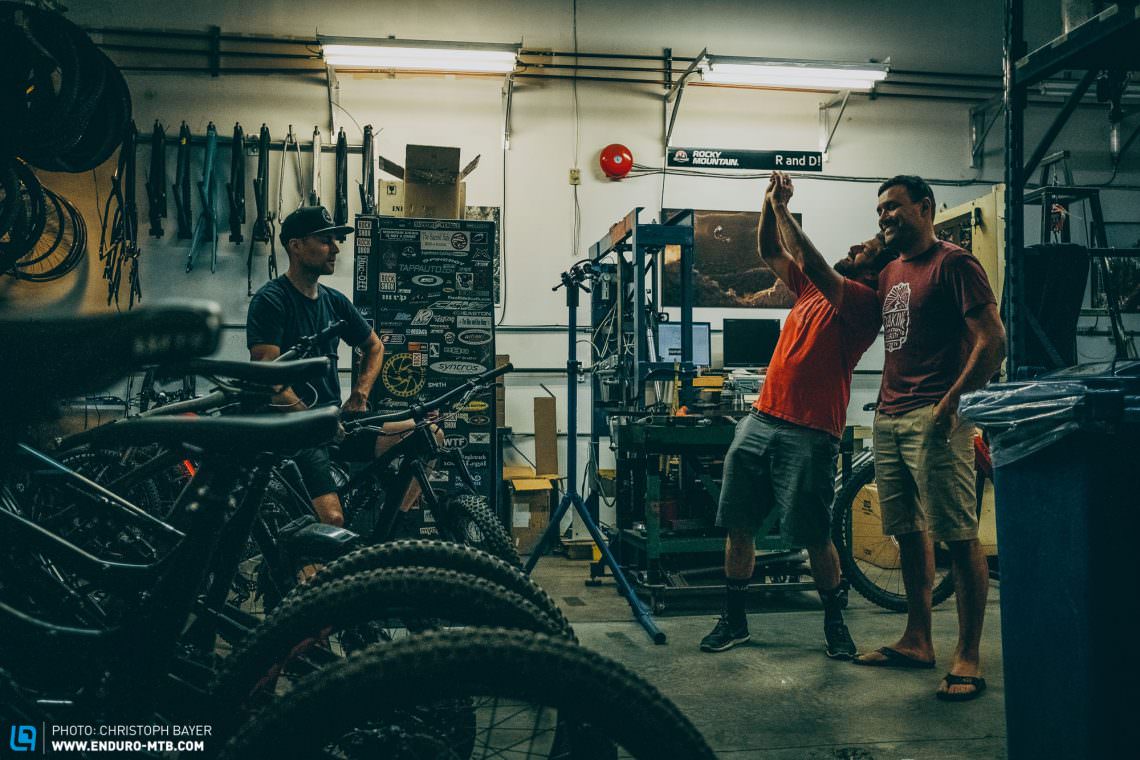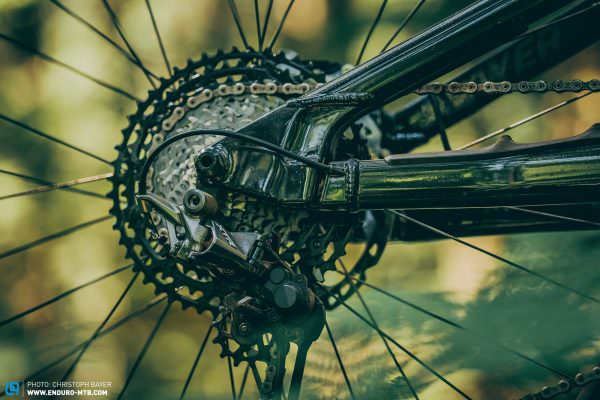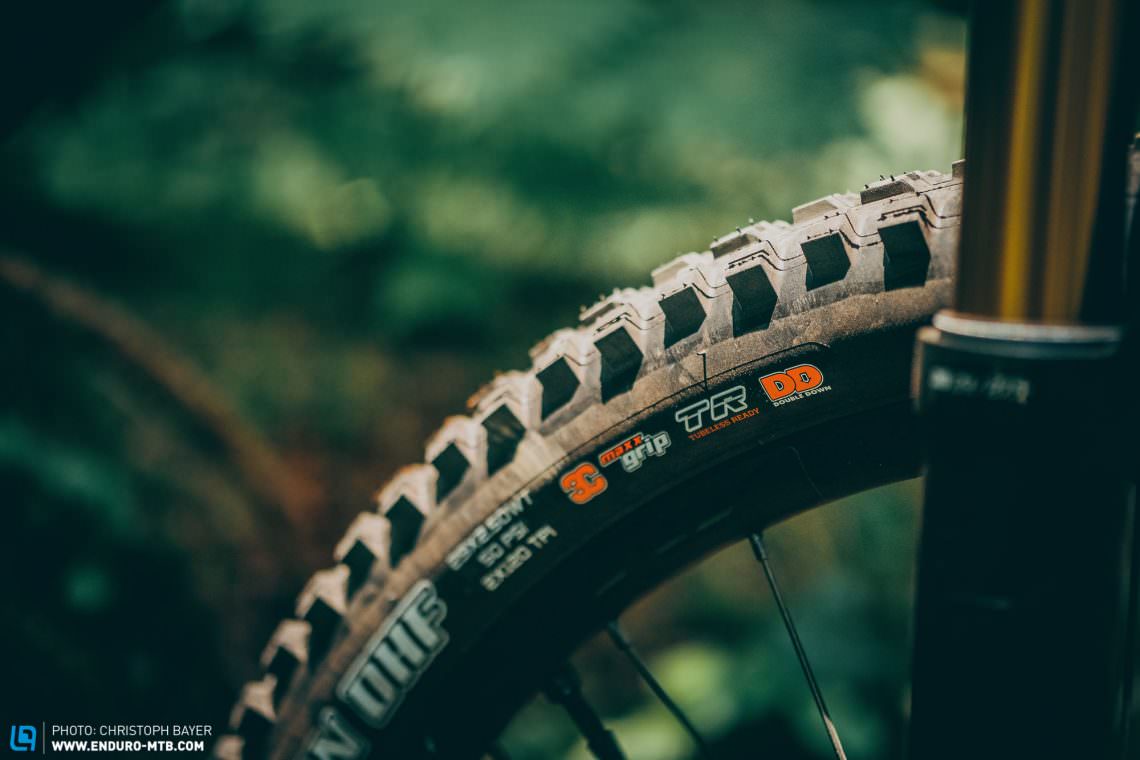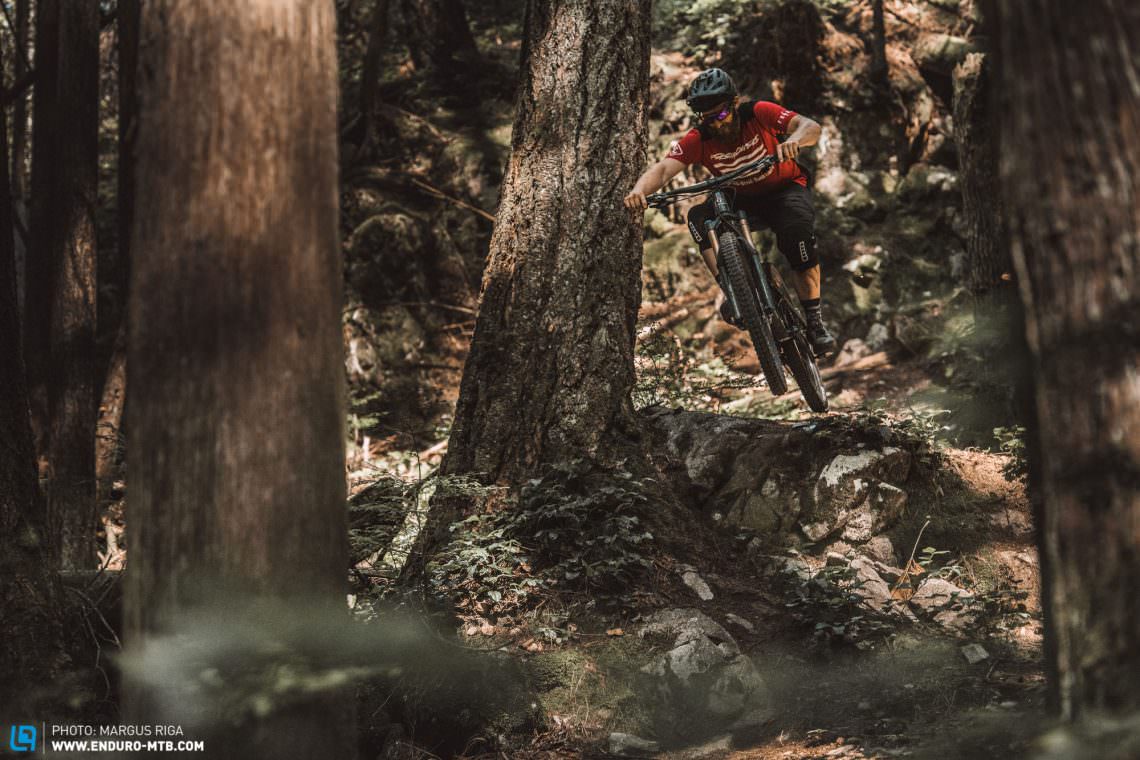SLAYER! A word that you’ll immediately associate with heavy metal: fast, hard guitar riffs, headbanging and moshpits. Our first ride on the brand new Rocky Mountain Slayer did indeed shake us up and make us feel as electrified as you do after several-hours at a heavy-metal concert. The bike rocks!

Rocky Mountain had one goal when they developed the new Slayer: “this bike has to be rad!” At least that’s what the Canadian brand told us at the presentation at their headquarters in North Vancouver. They wanted to create a bike to go full throttle on the toughest tracks, a bike that you can hit the craziest lines on and not have to shy away from the highest drops. A freeride bike from the good old days that also climbs well and features all the modern technology that we’ve come to expect.


When they started the project, Rocky Mountain only envisioned the Slayer rolling on 27.5″ wheels. But when they saw the first hard-hitting 29ers appear on the scene, the Canadian brand made some in-house prototypes and soon decided that they would offer the bike with both wheel sizes. Having said that, you can’t just change the wheel size as you like, you have to decide on a size before you buy the bike – there’s no flip-chip. However, the new Slayer does feature Rocky Mountain’s Ride4 system allowing you to adjust the geometry in four positions.







Maximum reserves – the suspension of the new Rocky Mountain Slayer
The 29″ model has a whopping 170 mm travel on the front and rear while the 27.5″ bike offers an additional 10 mm on top of that. Like the previous Slayer, the new model relies on a four-bar rear linkage, but the kinematics of the bike have been revised, adjusting the anti-squat, anti-rise and leverage ratio. This should result in a bike that is more sensitive and more active – even when braking. The new Slayer has also been optimised for the use of coil shocks.

Robust, reliable and easy to service – the frame
Besides offering the new Slayer with two different wheel sizes, Rocky Mountain are also giving their customers a choice of carbon and aluminium for the frames. However, the rear end is made of aluminium across the range, which promises to be particularly durable in case of crash or a botched landing. Rocky Mountain also paid careful attention to the bike’s longevity with its specially sealed bearings. However, should you have to replace anything, all you need a number 5 and 6 Allen key to disassemble the rear linkage. The number of parts has been reduced to make the process that much easier. On the Carbon model, the cables are routed internally through carbon sheaths inside the frame, which makes replacing/installing brake lines and shifter cables hassle-free and keeps everything nice and quiet. The aluminium models don’t have any internal guides but the cable inlets should be big enough to make the cable routing less of a headache.


Long and slack, but not extreme – the geometry of the Rocky Mountain Slayer
In times when more and more companies are trying to outdo each other with ever more extreme geometries, Rocky Mountain seems a little reserved with the Slayer’s geometry, which is a long and slack but not to an extreme – we applaud them for doing so. The 475 mm reach in size L is just right for 180 cm tall riders. The head angle of 64.5 ° (neutral setting) is slack but not too much so and the chainstays are neither exaggeratedly short nor super long at 442 mm (29 “). The bottom bracket is positioned rather low considering the amount of travel available. Rocky Mountain deliberately kept the seat tube angle steep at 76.5° to position the rider centrally on the bike when going up steep climbs.
Rocky Mountain are offering the 29er in sizes M, L and XL, whereas the 27.5” model is available from S to XL.
The geometry table of the 29″ Slayer’s four settings
| Size | MD | LG | XL | |||||||||
|---|---|---|---|---|---|---|---|---|---|---|---|---|
| Ride 4 Pos. | 1 slack | 2 | 3 neutral | 4 | 1 slack | 2 | 3 neutral | 4 | 1 slack | 2 | 3 neutral | 4 |
| Seat tube [mm] | 420 | 445 | 480 | |||||||||
| Top tube [mm] | 600 | 599 | 598 | 595 | 628 | 627 | 626 | 623 | 657 | 656 | 655 | 652 |
| Head tube [mm] | 95 | 110 | 125 | |||||||||
| Head angle | 63.8° | 64.1° | 64.5° | 64.8° | 63.8° | 64.1° | 64.5° | 64.8° | 63.8° | 64.1° | 64.5° | 64.8° |
| Seat angle | 75.8° | 76.1° | 76.5° | 76.8° | 75.8° | 76.1° | 76.5° | 76.8° | 75.8° | 76.1° | 76.5° | 76.8° |
| Chainstay [mm] | 443 | 442 | 442 | 441 | 443 | 442 | 442 | 441 | 443 | 442 | 442 | 441 |
| BB Drop [mm] | 34 | 30 | 25 | 18 | 34 | 30 | 25 | 18 | 34 | 30 | 25 | 18 |
| Wheelbase [mm] | 1220 | 1219 | 1218 | 1215 | 1249 | 1248 | 1247 | 1244 | 1286 | 1285 | 1284 | 1281 |
| Reach [mm] | 462 | 466 | 470 | 473 | 469 | 471 | 475 | 478 | 492 | 496 | 500 | 503 |
| Stack [mm] | 622 | 619 | 616 | 614 | 635 | 632 | 629 | 627 | 649 | 646 | 643 | 641 |
The geometry table of the 27.5″ Slayer’s four settings
| Size | SM | MD | LG | XL | ||||||||||||
|---|---|---|---|---|---|---|---|---|---|---|---|---|---|---|---|---|
| Ride 4 Pos. | 1 slack | 2 | 3 neutral | 4 | 1 slack | 2 | 3 neutral | 4 | 1 slack | 2 | 3 neutral | 4 | 1 slack | 2 | 3 neutral | 4 |
| Seat tube [mm] | 380 | 420 | 460 | 480 | ||||||||||||
| Top tube [mm] | 570 | 573 | 573 | 572 | 596 | 597 | 597 | 596 | 624 | 623 | 622 | 621 | 660 | 659 | 658 | 658 |
| Head tube [mm] | 90 | 95 | 110 | 125 | ||||||||||||
| Head angle | 63.9° | 64.2° | 64.5° | 64.8° | 63.9° | 64.2° | 64.5° | 64.8° | 63.9° | 64.2° | 64.5° | 64.8° | 63.9° | 64.2° | 64.5° | 64.8° |
| Seat angle | 75.4° | 75.7° | 76° | 76.3° | 75.4° | 75.7° | 76° | 76.3° | 75.4° | 75.7° | 76° | 76.3° | 75.4° | 75.7° | 76° | 76.3° |
| Chainstay [mm] | 431 | 430 | 430 | 429 | 431 | 430 | 430 | 429 | 431 | 430 | 430 | 429 | 431 | 430 | 430 | 429 |
| BB Drop [mm] | 18 | 14 | 10 | 6 | 18 | 14 | 10 | 6 | 18 | 14 | 10 | 6 | 18 | 14 | 10 | 6 |
| Wheelbase [mm] | 1180 | 1179 | 1178 | 1177 | 1205 | 1204 | 1203 | 1202 | 1234 | 1233 | 1232 | 1231 | 1273 | 1272 | 1271 | 1270 |
| Reach [mm] | 419 | 422 | 425 | 428 | 444 | 447 | 450 | 453 | 469 | 472 | 475 | 478 | 494 | 497 | 500 | 503 |
| Stack [mm] | 595 | 593 | 591 | 589 | 600 | 598 | 596 | 594 | 614 | 612 | 610 | 608 | 627 | 625 | 623 | 621 |
Three carbon, two aluminium and one frameset – the Slayer models
As with its predecessor, the new Rocky Mountain Slayer is available in various builds with the same two colours options for each. As a customer, you either have the choice between a striking red/black or a very discreet black/grey colour scheme. Rocky Mountain affectionately call them “heartbreaker red/the main black” or “touch of grey/”. Overall, Rocky Mountain are offering three carbon and two aluminium models and most of them in both wheel sizes. The only exception is the carbon 50 model, which is only available as a 29er.

Interesting to see, all but the most affordable Alu 30 model feature a Shimano drivetrain. However, only the Carbon 90 model is specced with FOX components while the rest of the models rely on RockShox for the suspension. Prices start at € 3,500 for the Slayer Alu 30 and end at € 8,600 for the perfectly specced flagship model. The € 4,200 Slayer Alu 50 with the RockShox Lyrik Select+ fork, Super Deluxe Ultimate shock and complete Shimano SLX groupset, and the identically specced C50 carbon model for € 5,300 look like the most exciting options. Alternatively, you can get the carbon frameset for € 4,200.





The different models at a glance
| Carbon 90 | Carbon 70 | Carbon 50 | Alloy 50 | Alloy 30 | |
|---|---|---|---|---|---|
| Fork | 170/180 mm (29″/27.5″) | FOX 36 Factory GRIP2 | RockShox Lyrik Ultimate | RockShox Lyrik Select | RockShox Lyrik Select | RockShox Yari RC |
| Schock | 170/180 mm (29″/27.5″) | FOX DHX2 Factory | RockShox Super Deluxe Coil Ultimate | RockShox Super Deluxe Coil Ultimate | RockShox Super Deluxe Coil Ultimate | RockShox Super Deluxe Coil Select |
| Brakes | 200/200 mm | Shimano XTR 4-Pods | Shimano XT 4-Pods | Shimano SLX 4-Pods | Shimano SLX 4-Pods | Shimano MT520 4-Pods |
| Drivetrain | Shimano XTR 12-Speed | Shimano XT 12-Speed | Shimano SLX/XT 12-Speed | Shimano SLX/XT 12-Speed | SRAM SX Eagle |
| Wheelset | 29″/27.5″ | Race Face ARC 30/DT Swiss 340 | Race Face AR 30/DT Swiss 370 | WTB ST i30/DT Swiss 370 | WTB ST i30/DT Swiss 370 | WTB ST i30/Shimano MT400 |
| Tires | 2.5″ WT | Maxxis Minion DHF 3C MaxxGrip Doubel Down/Aggressor Dual Double Down | ||||
| Seatpost | Race Face Turbine R | OneUp Dropper Post | OneUp Dropper Post | Race Face Aeffect Dropper | Rocky Mountain Toonie Drop |
| Price | € 8,600 | € 6,500 | € 5,300 | € 4,200 | € 3,500 |
Confidence level 100 – the new Rocky Mountain Slayer on the trail
Riding the North Shore trails of Vancouver is something very special. The terrain is unlike anything you’ll encounter elsewhere in the world. Before we head down the first trail, Rocky Mountain Brand Manager Stephen tells us “do not trust anything, you are at the shore, if there might be a drop, there is a drop.” The terrain is usually steep, rough and full of holes that look for any opportunity to grab the front wheel and eject the rider over the bars.


With a rider height of 180 cm, we rode the 29″ Slayer Carbon 90 in size L. What immediately stood out to us is the extremely plush and sensitive rear suspension of the Slayer. With a weight of around 87 kg, the 475 lbs coil was perfect, giving us exactly 30% sag. On our way to the trail, we noticed how easily the Slayer manuals. As soon as we started heading downhill, the bike impressed us with the amount of traction it offers. Besides the unfamiliar terrain, the slack head angle and the 40 mm short stem made the front feel uncontrolled. We tried solving the problem by lowering the stem but we would personally have preferred a 45 mm or 50 mm model.

You’re positioned very centrally on the bike and the low slung top tube gives you a good range of motion. Due to the rather moderate geometry, the bike’s handling feels very intuitive once you’ve gotten used to the short stem. As soon as the trail allows it, the Slayer motivates you to go as fast as possible. If you happen to encounter another one of those unexpected drops, you simply lift the front wheel and let the endless reserves of the suspension soak up the landing, no matter how rough it is. Having said that, the bike never feels sluggish, offering plenty of pop and always willing to get airborne. Another very positive aspect of the suspension is the enormous braking traction it generates. The powerful XTR brakes ensure optimal deceleration at all times and thanks to the robust Double Down tires we never suffered any punctures and always had a lot of grip on the occasionally super loose and soft ground.

Thanks to the steep seat tube angle, your riding position is upright and compact on the climbs. We never felt the need to push the saddle further forward – which we usually do on almost every other bike we’ve tested. The rear suspension generates a lot of traction on technical climbs and doesn’t wallow. However, on forest service roads and monotonous climbs, you’ll notice a significant amount of pedal bob on the super plush suspension – you’ll want to reach for the climb switch to calm things down.

Our first conclusion after a day on the Slayer
The careful attention to detail, good looks and, above all, the outstanding rear suspension convinced us of the new Rocky Mountain Slayer. Super sensitive, massive reserves and yet very defined – we were thrilled. The geometry is balanced and the spec is beyond reproach. If you’re looking for an enduro bike to tame the wildest trails, we recommend taking a closer look at the new Slayer. We can’t wait to spend more time testing it.
Tops
- super sensitive and defined suspension
- fun and composed handling
- good spec on all models
- clever details
- comfortable climbing position
Flops
- stem too short for some riders
- pedal bob on the climbs
More info at: bikes.com

Did you enjoy this article? If so, we would be stoked if you decide to support us with a monthly contribution. By becoming a supporter of ENDURO, you will help secure a sustainable future for high-quality mountain bike journalism. Click here to learn more.
Words: Photos: Christoph Bayer & Margus Riga

















